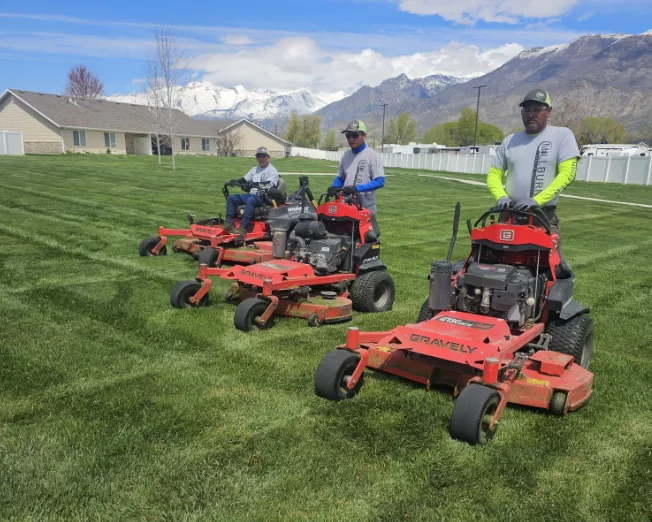Maintaining a lush, green lawn requires more than just a weekend mowing session. To keep your yard looking its best year-round, you need to adjust your lawn care practices to match the changing seasons. From mowing height to weed management, each season presents unique challenges and opportunities for your lawn. This detailed guide will walk you through the seasonal adjustments necessary to ensure a thriving lawn all year long.

Ready to elevate your property’s curb appeal and maintain a pristine landscape year-round? Hire Millburn Lawn & Landscape for expert property maintenance services that ensure your outdoor spaces stay beautiful and healthy. Contact us today to schedule your service and experience the difference professional care can make!
Spring: Revitalizing Your Lawn After Winter Weed Management

1. Adjusting Your Mowing Routine
As temperatures rise in spring, your lawn will begin its growth spurt. It’s crucial to start mowing as soon as the grass becomes active. Here’s what you need to do:
- Mowing Height: Set your mower blade to a higher setting. Cutting grass too short can stress it, especially as it emerges from winter dormancy. Aim for about 2.5 to 3 inches.
- Frequency: Mow your lawn weekly or bi-weekly, depending on growth rate. Regular mowing promotes healthy, dense grass.
2. Spring Weed Management
Spring is also when many weeds start to emerge. To manage them effectively:
- Pre-Emergent Herbicides: Apply pre-emergent herbicides early in spring to prevent weed seeds from germinating.
- Spot Treatment: For existing weeds, use a targeted herbicide or manually remove them to avoid competition with your grass.
Summer: Maintaining Your Lawn Through the Heat Weed Management

1. Mowing Adjustments
In the summer months, heat and drought can stress your lawn. Adjust your mowing practices to:
- Mowing Height: Raise your mower blade to 3 to 4 inches. Taller grass shades the soil, reducing moisture evaporation and preventing weed growth.
- Timing: Mow in the early morning or late afternoon to avoid the heat of midday, which can cause additional stress to your lawn.
2. Summer Weed Management
Weed growth can be vigorous during summer. To keep them under control:
- Post-Emergent Herbicides: Use post-emergent herbicides to target and eliminate summer weeds. Be sure to follow the manufacturer’s instructions for application rates and timings.
- Watering Practices: Keep your lawn hydrated with deep, infrequent watering. This helps maintain a strong root system and makes it harder for weeds to take hold.
Fall: Preparing Your Lawn for Winter Weed Management

1. Mowing Tips for Autumn
As temperatures cool and grass growth slows, modify your mowing routine:
- Mowing Height: Gradually lower your mower blade to about 2 inches to prepare your lawn for winter. This helps reduce the risk of fungal diseases.
- Leaf Management: Regularly remove fallen leaves to prevent them from suffocating your grass and causing fungal issues.
2. Fall Weed Management
- Fall Fertilization: Apply a fall fertilizer to strengthen grass roots. This will help your lawn bounce back in the spring.
- Weed Control: Apply a fall weed killer to target stubborn weeds that may have emerged during the season. This will reduce their ability to spread over winter.
Winter: Maintaining Lawn Health Weed Management

1. Minimal Mowing
In winter, grass growth slows considerably, so mowing is usually unnecessary. However, if the grass grows a bit, you can mow lightly if needed.
2. Winter Weed Management
While weeds are less active in winter, it’s a good time to plan for the coming year:
- Prevention: Consider applying pre-emergent herbicides before the ground freezes if the product is suitable for your region.
- Planning: Review your lawn care strategies and plan adjustments based on the results from the past year.
Conclusion
Seasonal lawn care is essential for maintaining a healthy and beautiful lawn throughout the year. By adjusting your mowing practices and weed management strategies to fit each season, you can ensure your lawn remains lush and green. Whether it’s through height adjustments in spring, proper hydration in summer, or strategic treatments in fall, each season requires specific care to keep your lawn at its best.




